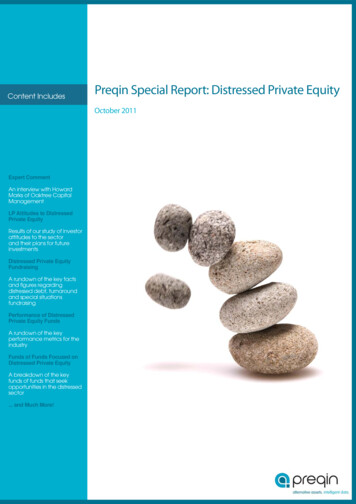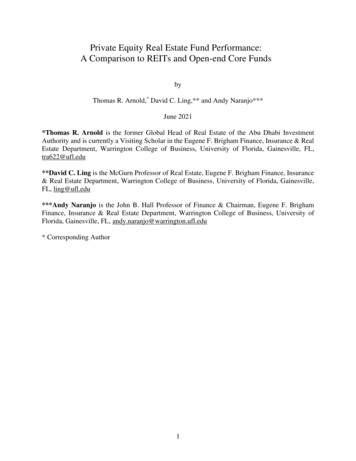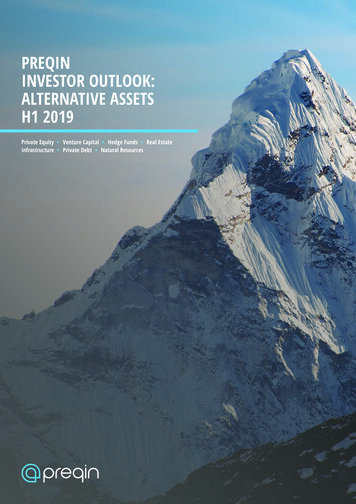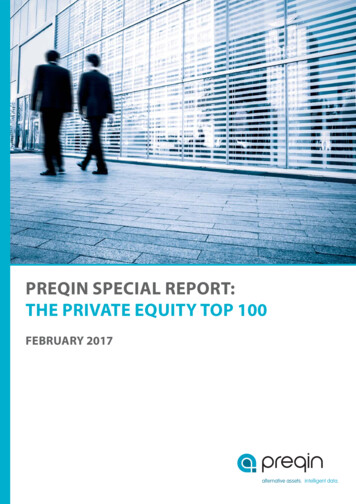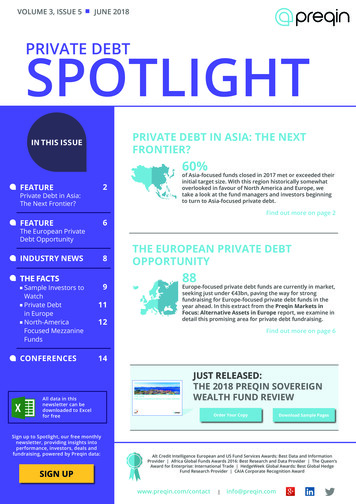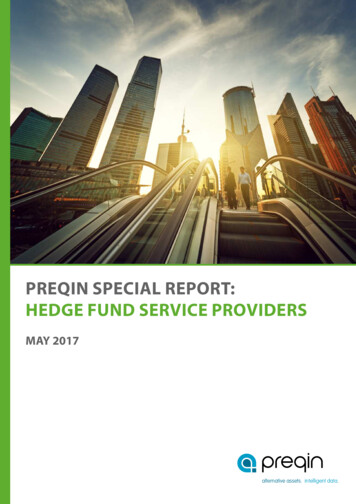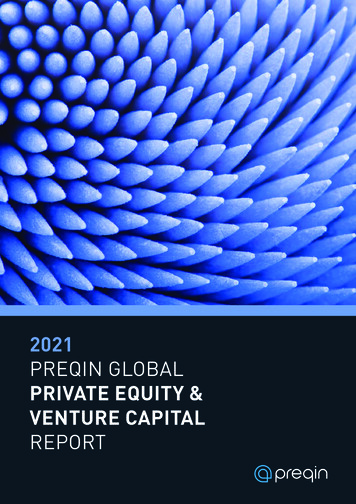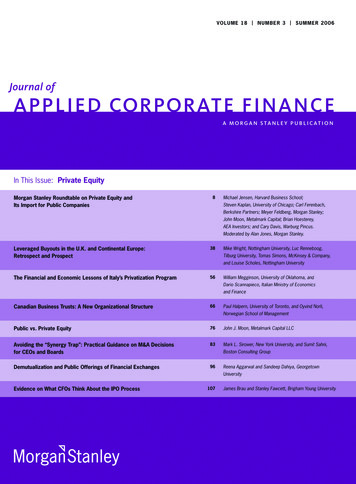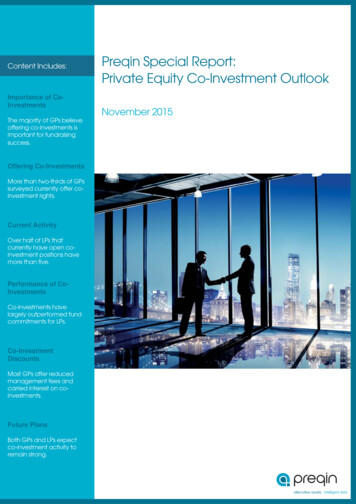
Transcription
Content Includes:Importance of CoInvestmentsPreqin Special Report:Private Equity Co-Investment OutlookNovember 2015The majority of GPs believeoffering co-investments isimportant for fundraisingsuccess.Offering Co-InvestmentsMore than two-thirds of GPssurveyed currently offer coinvestment rights.Current ActivityOver half of LPs thatcurrently have open coinvestment positions havemore than five.Performance of CoInvestmentsCo-investments havelargely outperformed fundcommitments for LPs.Co-InvestmentDiscountsMost GPs offer reducedmanagement fees andcarried interest on coinvestments.Future PlansBoth GPs and LPs expectco-investment activity toremain strong.alternative assets. intelligent data.
Preqin Special Report: Private Equity Co-InvestmentOutlookDownload the data pack:www.preqin.com/CoInv15ForewordAs private equity continues to grow as an asset class, investment structures and relationships between fund managers and investorshave had to evolve and adapt. LPs’ approaches to private equity are becoming more sophisticated as their knowledge of the assetclass increases, and many now frequently seek out alternative opportunities to fund investing in order to both diversify their portfoliosand maximize returns. As a result, growing numbers of LPs consider co-investments an important part of their overall private equityportfolios. Direct investments, whereby LPs are co-investing alongside GPs, have increasingly become part of private equity discourse,with significant interest arising from both sides. In the last year or so, Preqin has noted an increase in appetite for information relating toco-investments with a high number of incoming enquiries requesting greater insight on the subject.In order to find out more about this growing area of the asset class, we have surveyed 320 active GPs and 222 active LPs aboutco-investments and have examined the results to better understand the changing levels of co-investment participation among fundmanagers and investors, and to find out their views on the perceived risks and attractions.Half of the 222 LPs that we surveyed are either actively or opportunistically co-investing at present. Furthermore, most LPs are looking toeither increase or maintain their exposure to co-investments in the future, with a number of LPs aiming to make more co-investments andto commit more capital to these types of opportunities. Similarly, GPs are recognizing how important co-investment rights are becomingto LPs; our GP survey found that most managers feel offering co-investment rights is important during fundraising (page 4). In fact, 30%of GP respondents also stated that 81-100% of LPs in their latest funds have co-investment rights included in their LPAs.The main motivation for LPs to seek out co-investments is the prospect of greater returns and lower fees. Most LPs actively coinvesting reported that their co-investments have delivered superior returns to their private equity fund commitments, with 46% statingthat their past co-investments have outperformed fund investments by more than 5%, in contrast to just 3% of LPs witnessing anyunderperformance. The majority of GPs also reported that they charge lower management fees and carried interest on co-investmentarrangements, or charge no fees at all.Our survey suggests more and more LPs are set to seek out opportunities to make co-investments. With the fundraising environmentbecoming increasingly competitive and record numbers of funds in market, it is also likely that GPs will be looking to more readily offerbenefits such as co-investment rights in order to improve their chance of a successful fundraise.To find out more about Preqin’s suite of private equity products, or for more information on co-investments, please do not hesitate tocontact us at info@preqin.com or at our New York, London, Singapore, San Francisco or Hong Kong offices.ContentsBreakdown of Survey Respondents3GP Perception of Co-Investments4GP Co-Investment Activity5LP Relationship7LP Co-Investment Activity9Performance of Co-Investments11LP Co-Investment Preferences12GP Relationship14GP and LP Co-Investment Future Plans15All rights reserved. The entire contents of Preqin Special Report: Co-Investment Outlook, November 2015 are the Copyright of Preqin Ltd. No part of this publication or any information contained in it may be copied, transmitted by any electronicmeans, or stored in any electronic or other data storage medium, or printed or published in any document, report or publication, without the express prior written approval of Preqin Ltd. The information presented in Preqin Special Report: CoInvestment Outlook, November 2015 is for information purposes only and does not constitute and should not be construed as a solicitation or other offer, or recommendation to acquire or dispose of any investment or to engage in any other transaction, or as advice of any nature whatsoever. If the reader seeks advice rather than information then he should seek an independent financial advisor and hereby agrees that he will not hold Preqin Ltd. responsible in law or equity for any decisionsof whatever nature the reader makes or refrains from making following its use of Preqin Special Report: Co-Investment Outlook, November 2015. While reasonable efforts have been made to obtain information from sources that are believed to beaccurate, and to confirm the accuracy of such information wherever possible, Preqin Ltd. does not make any representation or warranty that the information or opinions contained in Preqin Special Report: Co-Investment Outlook, November 2015are accurate, reliable, up-to-date or complete. Although every reasonable effort has been made to ensure the accuracy of this publication Preqin Ltd. does not accept any responsibility for any errors or omissions within Preqin Special Report: CoInvestment Outlook, November 2015 or for any expense or other loss alleged to have arisen in any way with a reader’s use of this publication.2 2015 Preqin Ltd. / www.preqin.com
Download the data pack:www.preqin.com/CoInv15Preqin Special Report: Private Equity Co-InvestmentOutlookBreakdown of Survey RespondentsTotal Number of GPs Surveyed: 320Total Number of LPs Surveyed: 222Breakdown of GP Respondents by LocationBreakdown of LP Respondents by LocationNorth AmericaEurope47%29%Asia9%North AmericaEurope48%35%Rest of World15%Asia8%Rest of World9%Source: PreqinSource: PreqinBreakdown of LP Respondents by TypeGP Respondents by Primary Investment TypeFund of Funds ManagerReal Estate4%3% 4%24%6%Asset Manager9%Buyout8%19%Family OfficePublic Pension Fund5%Growth16%4%4%Venture Capital17%Infrastructure5%Mezzanine7%Private Sector Pension FundInsurance Company16%Endowment PlanFoundationDistressed Private Equity8%Investment Company13%Natural Resources13%16%BankOtherOtherSource: PreqinGP Respondents by Size of Most Recent FundSource: PreqinLP Respondents by Assets under Management5% 1%Less than 500mnLess than 250mn18%24% 250-499mn22% 500mn-1.5bn 500-999mn11% 1-4.9bn 1.6-4.5bn12%72%7%More than 4.5bn 5-9.9bnMore than 10bn27%Source: Preqin 2015 Preqin Ltd. / www.preqin.comSource: Preqin3
Preqin Special Report: Private Equity Co-InvestmentOutlookDownload the data pack:www.preqin.com/CoInv15GP Perception of Co-InvestmentsDiscussions on the disintermediation of private equity arebecoming more common, and increasing numbers of institutionalinvestors are considering making direct private equityinvestments. It therefore comes as no surprise to hear that themajority of private equity fund managers feel that it is importantto offer potential investors co-investment rights when seekingnew commitments and that they feel this increases the chancesof a successful fundraise, as shown in Fig. 1.Fig. 1: Importance of Being Open to OfferingCo-Investment Rights for a Successful Fundraise17%9%Vitally ImportantVery ImportantIn order to gain more insight into GP opinion on co-investments,we asked private equity fund managers what they perceive to bethe pros and cons of offering LPs co-investment rights. Just 2%of GP respondents stated that there are no benefits in offeringLPs co-investment rights.35%Somewhat ImportantNot Important39%Of those respondents that indicated there are advantages, threebenefits in particular were cited by the majority of fund managers:building stronger relationships with LPs (84%), gaining access toadditional capital for deals (76%) and improving the chance of asuccessful fundraise (55%), as shown in Fig. 2.Source: Preqin Fund Manager Survey, August 2015When asked what the downsides of offering LPs co-investmentrights are, 9% of fund managers stated that there are none. Ofthose respondents that indicated there are negatives, the mostprominent factor is the impact offering co-investment rights hason the timeline of deals; 69% of fund managers feel offering theirinvestors co-investment rights delays the deals process (Fig.3). Just over a quarter of respondents (26%) noted the negativeimpact it has on relationships with LPs that are not offered suchopportunities. One North America-based private equity firmmanages this issue by offering the transaction to its LPs on afirst-come first-served basis.Private Equity OnlinePrivate Equity Online is Preqin’s flagship online privateequity information resource.Constantly updated by our team of dedicated researchers,Private Equity Online represents the most comprehensivesource of industry intelligence available today, with globalcoverage and a wide variety of information included.For more information, please 0%10%1%OtherOpportunity toEnhance ProductDifferentiationOpportunity toBetter Manage RiskBenefits to thePortfolio CompanyImprove theChance of aSuccessful FundraiseGain Access toAdditional Capitalfor Deals0%Source: Preqin Fund Manager Survey, August ative Impacton Relationshipswith Other ces in theTerms or Rightsof Co-Investors76%Slows DealsProcess84%80%Fig. 3: Perceived Disadvantages of Offering LPsCo-Investment RightsProportion of GP Respondents90%Build a StrongerRelationship with LPsProportion of GP RespondentsFig. 2: Perceived Benefits of Offering LPs Co-InvestmentRightsSource: Preqin Fund Manager Survey, August 2015 2015 Preqin Ltd. / www.preqin.com
Download the data pack:www.preqin.com/CoInv15Preqin Special Report: Private Equity Co-InvestmentOutlookGP Co-Investment ActivityGP OfferingsFig. 4: Proportion of GPs Offering Co-Investment Rights toTheir LPsMore than two-thirds (69%) of the GPs surveyed offer coinvestment rights to their private equity fund investors, and afurther 18% are considering doing so in the future (Fig. 4). Lessthan 1% of respondents had offered co-investments in the pastbut do not offer them any longer. This reinforces the prevalenceof co-investments, and the sustained, or even increasing,appetite that is apparent in the private equity industry for thesedirect investment types.Syndicated co-investments, whereby a GP sells down a portionof equity to select LPs after the deal has been completed, are themost prevalent type of co-investments that fund managers offertheir investors, stated by 74% of GP respondents (Fig. 5). Only16% offer a co-sponsorship model, requiring a significant levelof due diligence from LPs at an early stage in the deals process.An even smaller proportion offer the opportunity for LPs to colead (13%), where the investor will contribute a similar share tothe fund manager and has a leading role in deal origination. It isnoteworthy that these latter two options, which allow LPs moreactive roles alongside GPs, are the least prevalent.Fig. 6 shows the typical stage in the investment cycle at whichfund managers offer co-investment rights to LPs. Thirty-eightpercent of GPs offer these opportunities at more than one stagein the process. The most common point at which investors areoffered co-investment rights is during the fundraising process orduring the bid for deals. It is rarer for GPs to offer them at finalclose of the fund, with only 7% of respondent fund managersdoing so.Co-Investment Activity in 2014 and H1 2015In order to track the changes and developments in the privateequity co-investment space, we asked fund managers about theiractivity in 2014 compared to H1 2015, with the results clearlyillustrating the growth in co-investments in a relatively short periodof time. Fig. 7 demonstrates that GPs are generally offering anFig. 5: Types of Co-Investment Opportunities GPs Offer LPs0%Considering OfferingCo-Investment Rights18%69%Source: Preqin Fund Manager Survey, August 2015increasing proportion of their LPs co-investment opportunities;between 2014 and H1 2015, the proportion of fund managersoffering 0-30% of their LPs co-investment opportunities hasdropped, and in turn, the proportion offering these opportunitiesto more than 80% of their investors has risen considerably. In2014, 11% of GPs were offering more than four out of five LPsco-investments; this has risen to 26% in H1 2015.However, there appears to be some disparity in the proportionof LPs approached with co-investment opportunities and thosethat actually ended up committing to such transactions with theGP. Fig. 8 shows that, surprisingly, the greatest proportion of GPs(40%) stated that none of the LPs they offered co-investmentopportunities to in H1 2015 took them up, an increase from 29%in 2014.Generally LP co-investors would make up less than 50% of theequity in a deal; however, the proportion of GPs that indicatedtheir LP co-investors contributed over half of the equity in privateFig. 6: Typical Stage in Investment Cycle at Which GPsOffer Co-Investment Rights to e: Preqin Fund Manager Survey, August 2015 2015 Preqin Ltd. / www.preqin.com40%30%23%20%16%7%10%0%At Final Closeof Fund13%10%46%Pre-Marketingof Fund16%20%50%Post-DealCompletion27%58%During Bid forDeal40%60%DuringFundraisingProcess50%Proportion of GP Respondents60%30%Previously Offered CoInvestment Rights butDo Not AnymoreDo Not Offer CoInvestment Rights74%70%SyndicatedCo-InvestmentProportion of GP Respondents80%Offer Co-InvestmentRights13%Source: Preqin Fund Manager Survey, August 20155
Preqin Special Report: Private Equity Co-InvestmentOutlookequity deals rose from 11% in 2014 to 23% in H1 2015 (Fig. 9).Conversely, the proportion of GPs that had their co-investing LPscommitting 11-19% of the equity for deals halved from 24% in2014 to 12% in H1 2015.Download the data pack:www.preqin.com/CoInv15bracket moving from 2014 to H1 2015, with the most notable shiftin the category of deals worth 1bn and over. Of all 1bn privateequity deals completed by the GP respondents in 2014, 57% ofthese included LP co-investors, compared to just 20% in 2015.Size of Co-Investment DealsFig. 7: Proportion of LPs Offered Co-InvestmentOpportunities by GPs, 2014 vs. H1 2015Fig. 8: Proportion of LPs Offered Co-InvestmentOpportunities that Actually Ended Up Co-Investing withthe GP, 2014 vs. H1 2015Proportion of LPs Offered Co-InvestmentProportion of LPs Offered Co-InvestmentFig. 10 shows the average proportion of deals completed in2014 and H1 2015 that included LP co-investors by deal size.The overall trend is that smaller deals (those less than 500mnin size) are more likely to include an LP co-investor. Our surveyresults show that there have been slight changes within each size11%41-60%5%3%31-40%7%6%20145%21-30%6%8%H1 %61-80%1%4%1%41-60%7%31-40%5%5%21-30%5%201410%H1 201513%11-20%1-10%21%29%0%30%0%10%Proportion of GP Respondents20%Fig. 9: Proportion of Equity from LP Co-Investors in Deals,2014 vs. H1 20157%13%201411%6%22%22%20-29%H1 201524%12%73%69%83%73%67%61%63%60%57%201450%40%H1 201530%20%20%10%20%30%Proportion of GP RespondentsSource: Preqin Fund Manager Survey, August 2015 5099mn1-10%10%70%81%0%24%25%0%80%Less than 50mn11-19%50%Fig. 10: Size of Deals Completed that Included LP CoInvestors, 2014 vs. H1 2015Average Proportion of DealsIncluding LP Co-InvestorsProportion of Equity23%30-39%40%40%Source: Preqin Fund Manager Survey, August 201590%11%40-49%30%Proportion of GP RespondentsSource: Preqin Fund Manager Survey, August 201550% orMore35%18% 1bnor More5%4%4%81-100% 500999mn61-80%26% 100499mn81-100%Deal SizeSource: Preqin Fund Manager Survey, August 2015Data Source:Preqin’s Fund Manager Profiles has extensive information for over 9,300 active private equity firms worldwide. Detailed profilesinclude total capital raised in the last 10 years, estimated dry powder, number of portfolio companies, investment preferencesand much more. Plus, access direct contact information for key decision makers.For more information, please visit: www.preqin.com/fmp6 2015 Preqin Ltd. / www.preqin.com
Download the data pack:www.preqin.com/CoInv15Preqin Special Report: Private Equity Co-InvestmentOutlookLP RelationshipPreqin’s survey results highlighted the differing experiencesGPs have when co-investing with LPs. For example, the largestproportion (45%) of fund managers stated that the additionalcapital co-invested by their LPs typically equates to 1-20% of theLP’s original fund commitment (Fig. 11). However, for 9% of GPrespondents, the additional capital equated to 100% or more oftheir LPs’ original fund commitments.There can be a number of prerequisites for investors whenqualifying for co-investment rights. Over half (53%) of fundmanagers indicated that the speed at which the LP can evaluateand agree to co-investment is of high importance (Fig. 12). Thecompetitive bidding process and the fact that several co-investorsmay be waiting on one another’s decisions means that there issome pressure on timing, with GPs often looking for a verbalcommitment from LPs within as little as two to three weeks.requirements relating to LP reliability and 33% call for previousexpression of interest in order to qualify for co-investment rights.Twenty-six percent of fund managers have no requirements at alland will offer co-investment opportunities to all LPs.Despite the widely reported appetite for co-investment in today’sprivate equity industry, GPs are finding that only a certainproportion of their LPs are actually requesting rights to investalongside them. The largest share of respondents (41%) statedthat only up to 20% of LPs in their most recent fund requestedco-investment rights (Fig. 13). On the other hand, 11% of GPssurveyed had over 80% of their most recent LPs do so.Fig. 11: GPs’ Observations of Additional Capital TypicallyCo-Invested Alongside Fund Commitments by Their LPsFig. 12: Requirements for Investors to Qualify forCo-Investment Rights20%More than 100% ofFund Commitment10%3%0%Source: Preqin Fund Manager Survey, August 2015Fig. 13: Proportion of LPs in Most Recent Fund to RequestCo-Investment Rights26%20%Other81-100% of FundCommitment29%No Requirements,Offered to All LPs61-80% of FundCommitment15%33%LP Bite-SizeRequirements45%41-60% of FundCommitment35%30%Previous Expressionof Interest inCo-Investments4%40%40%LP Reliability21-40% of FundCommitment53%50%Size of FundCommitment9%6%60%Speed at WhichLP Can Decideon Co-Investment1-20% of FundCommitmentProportion of GP RespondentsThe size of fund commitments is of relative significance,highlighted by two in five GPs, while 35% of fund managers haveThe LPA outlines a number of key provisions in a private equityfund and it is not uncommon for these legal documents to containclauses on co-investment rights. The largest proportion of fundmanagers (30%) stated that 81-100% of LPs in their most recentfund had co-investment rights included in their LPA, as shown inFig. 14.Source: Preqin Fund Manager Survey, August 2015Fig. 14: Proportion of LPs in Most Recent Fund to Have CoInvestment Rights Included in %41-60%31-40%14%61-80%More than 80%1%41-60%9%61-80%2%8%24%Source: Preqin Fund Manager Survey, August 2015 2015 Preqin Ltd. / www.preqin.com15%81-100%Source: Preqin Fund Manager Survey, August 20157
2015 PREQIN PRIVATE EQUITYFUND TERMS ADVISORThe 2015 Preqin Private Equity Fund Terms Advisor is the ultimate guide to private equity fundterms and conditions, featuring analysis based on over 4,500 funds – more than ever before! Identify typical terms and benchmark funds to see how terms compare to the marketView actual terms and conditions data for over 2,500 fundsDownload data to conduct your own analysisModel the real economic impact of various termsReview data and analysis on the actual fees and costs incurred by LPsEvery purchase of the 2015 Preqin Private Equity Fund Terms Advisor includes a free 12-month subscriptionto Preqin’s Fund Terms Advisor online service.For more information, please visit:www.preqin.com/ftaalternative assets. intelligent data.
Download the data pack:www.preqin.com/CoInv15Preqin Special Report: Private Equity Co-InvestmentOutlookLP Co-Investment ActivityAccording to Preqin’s latest investor survey on co-investments,half of all LPs are actively, or opportunistically, co-investingalongside private equity fund managers at present (Fig. 15). Thisis in addition to 22% that are considering co-investing, havingnot done so before. This indicates that the vast majority of LPshave faith in co-investments and see the investment structureas an attractive way to access the asset class, with only 27%of LPs not looking to co-invest at the moment. For those LPsthat have never co-invested and with no future plans to coinvest, there seems to be very little pattern in either location oraggregate assets under management (AUM), with these LPsspread globally and with varying sizes of AUM.Fig. 15: Breakdown of LPs by Current Co-InvestmentActivityActively Co-Investing24%Opportunistically CoInvesting26%Have Not Co-InvestedPreviously, Will Consider inFuture3%Have Co-Invested Previously,But No Future PlansOf the investors that have at least one open co-investmentposition, the largest proportion (25%) currently hold betweenthree and five open co-investment positions, with 68% of LPsholding between one and 10 positions (Fig. 16). Six percent ofLPs with open positions currently hold over 50 co-investmentsalongside their private equity fund commitments. As coinvestments increase in prevalence, this number is likely torise as LPs become more confident and sophisticated in directinvesting.the future, and cite superior returns as a major perceived benefitof co-investing.Of the LPs surveyed, the average range for private equity coinvestments per position is 2-10mn. Many LPs seem to coinvest in a similar range to this, with the exception of some largerLPs that are willing to commit hundreds of millions of dollarsto a single co-investment position, and in one respondent’scase, up to 1bn. According to Preqin’s investor survey, themajority (63%) of LPs that are co-investing alongside their fundcommitments only invest between 1% and 20% of their initialstake in the fund via co-investment positions (Fig. 17). Thirtypercent of LPs typically commit between 21% and 100% to coinvestment positions, while 7% commit more to co-investmentsthan their entire stake in the original fund. Unsurprisingly, all LPsin this 7% are looking to increase their level of co-investment inAs shown in Fig. 18, over half (59%) of the LPs surveyed byPreqin confirmed that they take a ‘selective follower’ approachto co-investing, meaning that the LP undertakes significant,independent due diligence on deals, but at a later stage inthe process, and decides on a deal-by-deal basis whetheror not to invest in each opportunity. This was by far the mostcommon response from co-investing LPs, ahead of ‘passivefollowers’ (27%), which sees LPs perform some due diligence,although investors often commit to a co-investment opportunityregardless. Just 10% of LPs opt to ‘co-lead’ co-investmentdeals, whereby the LP takes on a leading role in origination andthe wider co-investment process. Co-lead opportunities may befew and far between however, with many GPs unwilling to offerFig. 16: Current Number of Open Co-Investment PositionsHeld by LPsFig. 17: Additional Capital Typically Co-Invested AlongsideFund Commitments by LPs6%21%24%22%Never Co-Invested, No Plansto Co-Invest in FutureSource: Preqin Investor Survey, September 20151-20% of FundCommitment7%1-21% 5%3-53%15%21-40% of FundCommitment41-60% of FundCommitment6-1012%11-2025%21-5021%61-80% of FundCommitment63%81-100% of FundCommitmentMore than 5022%More than 100% ofFund CommitmentSource: Preqin Investor Survey, September 2015 2015 Preqin Ltd. / www.preqin.comSource: Preqin Investor Survey, September 20159
Preqin Special Report: Private Equity Co-InvestmentOutlookIn contrast, LPs that do not co-invest, and have no plans to coinvest, seem to suggest that a lack of resources available tothem is the prime reason for not committing to co-investmentopportunities (Fig. 20). Surprisingly, these responses arenot solely from smaller sized LPs, with a number of suchrespondents managing assets in excess of 10bn. Furthermore,almost a fifth of respondents stated that they do not look to coinvest as it would reduce their level of diversification, leavingthem overexposed to certain deals by committing veFollowercapital to the same portfolio company. A very small 3% of LPsactually cited returns being too low as a reason for not currentlyco-investing, which is in contrast to the results shown in Fig. 19and Fig. 22 that LPs at large reap the benefits of outperformingco-investments.Source: Preqin Investor Survey, September herOtherGain Knowledgeof Industry SectorGain Access toSpecifc PortfolioCompanies0%More Controlover InvestmentsSource: Preqin Investor Survey, September 2015AllocationToo Small6%Strengthen GPRelationships2%0%ReturnsToo Low23%20%Lower Fees10%10%LegalRestrictions31%10%16%Not Part ofInvestment Plan40%34%20%20%Not 40%Lack ofResources67%60%50%Proportion of LP RespondentsNot Co-Investing70%59%60%Fig. 20: LPs’ Reasons for Not Co-Investing80%Better ReturnsProportion of LP RespondentsFig. 19: LPs’ Perceived Benefits of Co-Investing70%SelectiveFollowerThe potential for better returns and the attraction of lower feesseem to be the driving forces behind the majority of surveyedLPs deciding to opt for co-investments. As seen in Fig. 19, 67%of LPs believe that co-investing can lead to greater returns thanthose delivered by standard private equity fund arrangements.Additionally, 61% of investors are attracted to the prospect oflower fees charged on co-investment commitments, as detailedfurther on page 14. Interestingly, a third of LPs believe that coinvesting provides them with more control over investmentsand 31% of LPs stated a desire to invest in a particular portfoliocompany, highlighting that institutional investors increasinglywant to become more involved at a portfolio company level.Fig. 18: LP Approaches to Co-InvestmentsProportion of LP Respondentssuch a level of control to LPs. Furthermore, such a demandingrole may not be a viable option for those investors lacking inexperience or resources.Download the data pack:www.preqin.com/CoInv15Source: Preqin Investor Survey, September 2015Data Source:Preqin’s Investor Intelligence is the leading source of information on institutional investors in private equity funds worldwide,with more than 6,000 limited partners of all types profiled and regularly updated following direct communication with our dedicatedteam of multilingual analysts.Our online database of private equity investors lists all institutions actively investing in the asset class and includes detailed andup-to-date information about their plans for future investments.For more information, please visit:www.preqin.com/ii10 2015 Preqin Ltd. / www.preqin.com
Download the data pack:www.preqin.com/CoInv15Preqin Special Report: Co-InvestmentsPerformance of Co-InvestmentsFor the majority of LPs that have seen co-investment positionsproduce positive returns, there has been a notable level ofoutperformance when compared to private equity fund returns.Eighty percent of LPs have acknowledged an outperformance,with 46% witnessing returns that are over 5% greater than thosein the standard private equity fund arrangements. In contrast,only 3% of LPs have witnessed an underperformance. It is worthmentioning that many LPs responded stating that it was too earlyto tell in regards to co-investment returns, showing that the coinvestment structure remains a relatively new, albeit growing,way of committing to the private equity asset class.Fig. 21: LPs’ Level of Desired Outperformance ofCo-InvestmentFig. 22: Performance of Past Co-Investments Compared toPrivate Equity Fund ReturnsUnderperformed PE FundReturnsSource: Preqin Investor Survey, September 2015Outperformed PE FundReturnsSource: Preqin Investor Survey, September 2015Source new investors for fundsIdentify new investment opportunitiesConduct competitor and marketanalysisFind potential deal opportunitiesDevelop new businessRegister for demo access to find out how Preqin’s Private Equity Online canhelp your business:www.preqin.com/privateequity 5.1% or More0% 2.6% to 5%0%20%14%Up to 2.5%34%3%Performed theSame as PEFundsOutperforming PE FundReturns by 5.1% andover17%Up to -2.5%Outperforming PE FundReturns by 2.6% to 5%46%-2.5% to -5%30%36%50%45%40%35%30%25%20%15%10%5%0%-5% or MoreOutperforming PE FundReturns by up to 2.5%Proportion of LP RespondentsThe most common response for perceived benefits of co-investingfrom an LP perspective was the prospect of better returns, sonaturally investors will be anticipating a notable outperformancefrom co-investments compared with their traditional private equityfund commitments. As shown in Fig. 21, of those LPs surveyed,36% expect co-investments to outperf
Performance of Co-Investments Co-investments have largely outperformed fund commitments for LPs. Co-Investment Discounts Most GPs offer reduced management fees and carried interest on co-investments. Future Plans Both GPs and LPs expect co-investment activity to remain strong. Preqin Special Report: Private Equity Co-Investment Outlook November .
